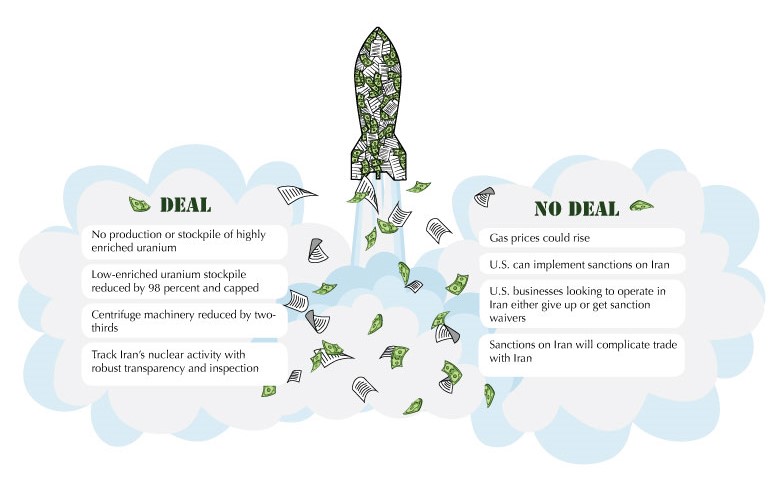U.S. WITHDRAWS FROM IRAN NUCLEAR DEAL
Shirking restrictions and sponsoring terrorism is a good enough reason to exit

Graphic by Sheila Embers // The Advocate
Iran, Trump, and nuclear deals, oh my: The Iran nuclear deal is a complex agreement involving a lot of documents and money. And there is no simple answer to this dilemma. In fact, every potential answer has its pros and cons.
First, some key background.
In 2015, the Obama administration formulated an agreement, known as the Iran nuclear deal, which was further endorsed by Iran and P5+1 (the five permanent members of the United Nations Security Council – the United States, United Kingdom, Russia, France, and China – plus Germany). This agreement boiled down to three key points: sanctions relief, uranium enrichment, and inspections. Basically, this deal was to ensure that it would take Iran at least a year (if able elude detection) to aggregate enough nuclear material to make a bomb.
The previously imposed sanctions on Iran were crippling its economy, and leaders in Tehran, the capital, wanted them immediately removed. Upon the implementation of the 2015 deal, sanctions by the EU and U.S. and most of the U.N. sanctions were dropped. These sanctions consisted of freezes of weapons development and assets, and sanctions in trade, oil experts, and much more. Upon this relief, Iran gained access to $100 billion of previously frozen assets.
In exchange, Iran was to maintain only a fixed amount of enriched uranium, one of the most critical components of a nuclear bomb. The deal restricted the nation to just 300 kilograms (661 pounds), compared to the 100,000 kilograms (220,460 pounds) it used to have. It really came down to this: Iran could enrich uranium to a maximum 3.67 percent U-235 – a potency useful for civilian energy purposes, but far below that needed to produce a nuclear bomb.
Iran also was to allow inspections by international monitors, who would check a number of enrichment facilities, uranium mines, and plants that produced centrifuge machinery. One of the most crucial parts of this agreement was to give the P5+1 access to facilities, scientists, and documents related to nuclear research.
Overall, this deal sounded like the answer to a lot of pressing issues: It regulated Iran’s uranium enrichment and requires transparency in Iran’s nuclear program, in return for lifting economic sanctions. It appeared a win-win for everybody.
Accusations raised
Just one big problem: On April 30, just three weeks ago, Israeli Prime Minister Benjamin Netanyahu addressed Iran’s nuclear program at the defense ministry in Tel Aviv. He had one point to make, and he made it clear: “Iran lied. Big time.”
Netanyahu claimed that Israel has custody of a series of documents that make clear Iran continues to run a secret nuclear weapons program. These include 55,000 pages and 183 CDs obtained from Iran through an intelligence operation, and then authenticated by the U.S., he said. These documents are said to hold incriminating charts, presentations, blueprints, and videos relating to Iran’s weapons deceit.
Just like every president, President Trump took office with agenda full of campaign promises, one of those being a renegotiation of the Iran nuclear deal. Netanyahu’s claims about Iran lying came just weeks before Trump’s formal decision to withdraw from the Iran nuclear deal, and may have had significant impact in his decision, given the close relationship of Israel and U.S. as allies.
But, Trump had reasons beyond Netanyahu’s claims to withdraw from the Iran nuclear deal. Two reasons, actually: First, being that the Iran nuclear deal did not provide oversight of Iran’s manufacture of ballistic missiles that could launch nuclear warheads as far as the U.S.; and, second, being that Iran is the world’s leading sponsor for state terrorism.
The president’s intention with Iran is to slap the sanctions back on, as well with any other country that does international business with it. He wants to drive Iran’s economy to its knees, allowing it to have either a sustainable economy or a nuclear program – but not both.
Controversial move
President Trump’s exit from the Iran nuclear deal does come with some backlash. His wish to re-impose sanctions on Iran and any of its trade partners has created tension with some of our strongest allies in Europe. Critics, and even some of his own advisers, argued loudly against pulling out of the deal, too. Some even accuse the president of trying to incite a new conflict with Iran.
Yet, it’s important to remember that just because the U.S. withdrew from the Iran nuclear deal, this does not mean the arrangement no longer exist: We now have to see what the remaining P5+1 countries decide to do.
With Trump’s high-profile campaign promises to undo most of Obama’s policies in Iran, and the U.S. media’s swell job of portraying anything that has the name “Trump” associated with it as terrible, or ignorant, it’s difficult to decipher what is actually best for the security of our nation.
As I said before, the Iran nuclear deal is complex. A deep dive into every single pro and con could bore you to death. But maybe Trump is right about this one: Maybe we should, indeed, exit a deal that allows the economy of the world’s leading sponsor for state terrorism to soar. Something tells me that new nuclear weapons and a country that sponsors terrorism just shouldn’t go together.

Leave a comment